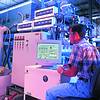

Users can create realtime measurement and automation solutions quickly with the intuitive LabView realtime graphical development environment and RT series hardware. This is done by placing functional blocks on a diagram and wiring them together. This form of data flow programming is analogous to scientific or engineering flow charts, making it easy to use. Convenient interactive debugging and execution of the finished application on the dedicated realtime processor enables faster time-to-market for realtime measurement and control.
Applications can be developed in the familiar Windows environment, then down-loaded as control code, to run on dedicated realtime hardware. Each hardware target has a dedicated processor running a realtime operating system independently from Windows. Even when rebooting the host computer, the realtime system continues to run uninterrupted. When rebooting the host system, the realtime hardware seamlessly reconnects without interrupting the control application.
Power functionality
Custom systems may be built with an unlimited combination of analysis, control and I/O tools. LabView realtime has hundreds of built-in control algorithms, signal processing libraries, analog and discrete data functions, and more. It is easy to build multitasking, multithreaded solutions with inherently parallel execution diagrams that maximise performance.
Strong hardware integration and scalability
The user can choose from a variety of RT series hardware. Add a realtime data acquisition component into a larger measurement and automation system or create a single standalone realtime solution with data acquisition, Signal Conditioning eXtensions for Instrumentation (SCXI), motion control, RS232, GPIB instrumentation and Ethernet connectivity. With the various hardware options, it is possible to create a system to meet precise needs today, while the modularity of the system means additions may be made to the solution as the system requirements grow.
Easy networking and connectivity
Open systems that connect to existing systems seamlessly using industry-standard communications protocols can be designed. Integration of Ethernet makes it possible to connect realtime nodes on a network, maximising the efficiency of the entire realtime system. The plug-in serial modules are used to communicate with other realtime systems or peripheral devices. With the built-in networking features of LabView, users can publish reports, share data or distribute tasks among multiple processors.
All this is accomplished using industry-standard development tools and technology resulting in excellent long-term investment and compatibility with existing systems as thousands of engineers use LabView.
National Instruments
(011) 805 8197

© Technews Publishing (Pty) Ltd | All Rights Reserved